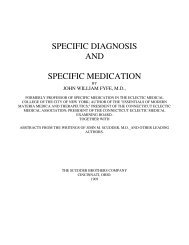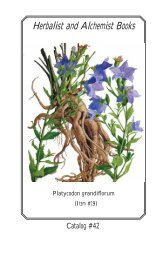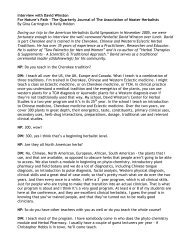MEDlCINAL PLANTS OF JAMAICA. PARTS 1 & 11.
MEDlCINAL PLANTS OF JAMAICA. PARTS 1 & 11.
MEDlCINAL PLANTS OF JAMAICA. PARTS 1 & 11.
Create successful ePaper yourself
Turn your PDF publications into a flip-book with our unique Google optimized e-Paper software.
In Jamaica the plant is said to be used for constipation. The vegetative parts are beaten and boiled to<br />
make tea to which a little castor oil or grease is added. This is also thought to be a 'purge for the blood'. For<br />
colds the plant is said to be used alone or with rattle weed (? Crotalaria). Browne and other early writers speak<br />
of the use of the shoots to prepare a drink for fevers, coughs and colds. It is still used in this way in the<br />
Grenadines. In Africa the leaves and roots are used for coughs and colds; the leaves to make an infusion for<br />
colic; the powdered leaves with palm oil for convulsions in children; the powdered leaves alone for conjunctivitis<br />
and to make a paste for boils; tho seeds for ophthalmia, snakebite, ulcers and worms. Similar use is made<br />
of the plant in India and Ceylon. (2, 3, 5, 7, 8, 10, 13, 14, 15, 18, 23, 24, 26, 27).<br />
ANDIRA INERMIS H. B. K. Cabbage Bark Tree: Cabbage Tree; Bastard Cabbage; Angeleen<br />
Tree; Worm Wood.<br />
For worms and phlegm Beckwith quotes a recipe which has more than a touch of magic in it, 'Take one<br />
chip where the sun rises, two where it goes down, boil as tea and sweeten. Eat a little piece of salt herring and<br />
drink the tea'. For wounds a plaster made of the grated 'nut' has been used but seems to be a somewhat painful<br />
remedy 'only some can stand it'. The bark is said to contain an alkaloid, berberine, and a methyltyrosin<br />
(andirin). It was at one time used in European medicine as a vermifuge but it is dangerous in large doses, producing<br />
vomiting with fever and delirium. (2, 7, 10, 14, 19, 27).<br />
CAJANUS CAJAN Millsp. Gungo (Congo) Pea: Pigeon or No-eye Pea.<br />
The seeds are a favourite food in Jamaica while the leaves are sometimes used to make tea for colds.<br />
Both the leaves and roots are said to contain tannins. In Africa the leaves have been used to prepare a gargle and<br />
mouthwash: for diarrhoea and for smallpox. (8, 10, 15).<br />
DESMODIUM SPP: including D. SUPINUM DC. Wild Pinder: Strong Back; Man Back; Bee Bur<br />
or Bush.<br />
D. supinum and probably other Desmodium species are used quite commonly to make tea for pains in<br />
the back. The whole plant is boiled either alone, or with other plants such as china root (Smilax sp.) sarsaparilla<br />
(Smilax ornata) Mimosa pudica and Chrysanthellum arnerkanum. The last two are said to be used to induce<br />
sleep in case of pain, while the first two together with unidentified species are used to make a tonic drink.<br />
Steggerda reports the use of Desmodium for colds and kidney troubles. In Lunan's day a decoction of<br />
Desmodium was considered to be a stomachic and. vermifuge, and the smoke from the burning leaves was used<br />
for headaches. Analyses of Desmodium show tbe presence of resins. (10).<br />
STYLOSANTHES HAMATA Taub. Donkey Weed: Pencil Flower: Lady's Fingers; Cheesy Toes.<br />
S. VISCOSA Sw. Poor Man's Friend.<br />
It is possible that these species are not distinguished by those using them medicinally. Both species are<br />
used in decoction for t1:e treatment of colds. In the Gambia S. viscosa is used for colds and as an ingredient of<br />
aphrodiasiac preparations. Beckwith says it is used In Jamaica for kidney trouble. (2, 7).<br />
PASSIFLORACEAE<br />
About three hundred and fifty species of warmer regions, including many tropical vines. The leaves and<br />
roots contain various compounds which yield hydrocyanic acid. These do not occur in the fruit pulp, however,<br />
which is often edible. They also contain salicylic acid.<br />
PASSIFLORA FOETIDA L. Love-in-a-Mist: Granadilla.<br />
The dry plant is used in some parts to make tea which is said to be 'good for the kidneys', as leaves<br />
contain 0.009 per cent hydrocyanic acid. (7, 10, 14, 27).







